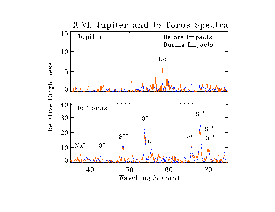

NOTE: Click on the image to view it at its highest resolution.
NASA's Extreme Ultraviolet Explorer (EUVE) satellite has obtained spectra of Jupiter and the Io torus before and during the impacts of comet SL-9.
The Jupiter spectrum in the upper panel shows strong helium emissions during the impacts that were not present immediately before the impacts began. The strongest emission is at 58.4 nm. An additional feature at 50.4 nm indicates that the emissions may result from recombination of helium ions. The presence of these emissions imply that substantial amounts of helium and/or helium ions have been lifted to high altitudes in Jupiter's upper atmosphere. Other features in the spectrum are currently unidentified.
The Io torus spectrum in the lower panel shows many emissions of sulfur, oxygen, and even sodium ions at wavelengths between 35 and 75 nm. At the present time we see no indications of substantial changes in the torus extreme ultraviolet emissions. The torus may respond to the impacts on a longer timescale, and EUVE will be monitoring Jupiter and the Io torus until the beginning of August to look for any changes in the system.
Randy Gladstone and the EUVE/SL9 team